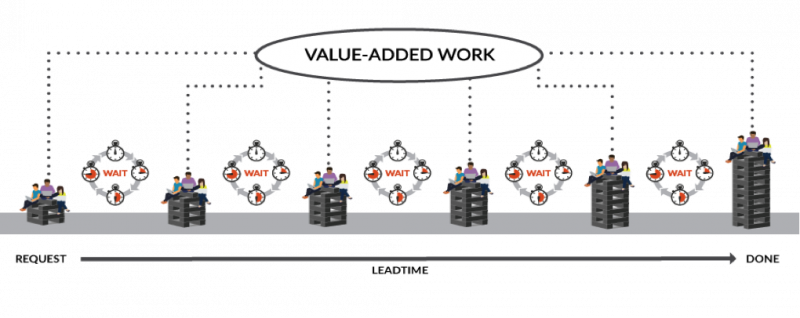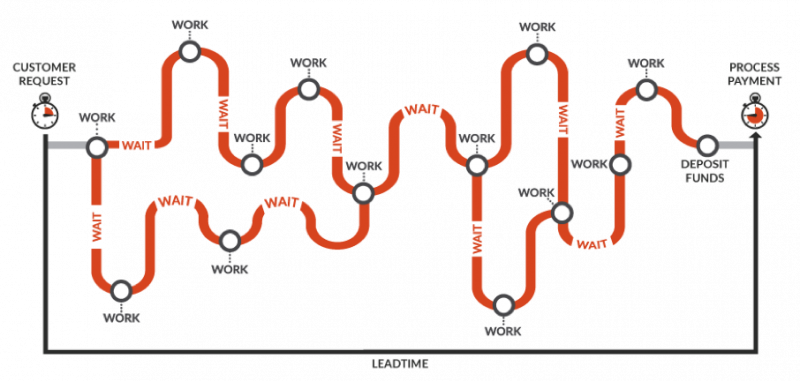Go to any lean, agile, or DevOps conference and you’ll hear speakers toss around the term value stream as if it’s as well understood as a game of checkers. Yet people are confused: What exactly is a value stream? A visual for repetitive work done in manufacturing? Some kind of process flow diagram? A lean kanban board?
Ambiguity abounds, so it’s important to clarify value streams: what they are, why they matter, and how to exploit them.
Value Is Contextual
Before diving into value streams, let’s acknowledge that the meaning of the word value itself is up for debate. People tend to value what is measured, but beware: Things that are easily measured (such as the number of deployments per day) may not be the most valuable thing for a company to base prioritization and investment decisions on.
In the book Value Stream Mapping: How to Visualize Work and Align Leadership for Organizational Transformation, a value stream is defined as the sequence of activities an organization undertakes to deliver on a customer request. This assumes customer value is the goal.
But what if the company defines value differently? What is the definition of value for a company that optimizes for return on investment (ROI) versus the customer experience? For profit versus time to market? For resource efficiency versus flow efficiency?
The book The Art of Business Value argues that business value is not a given, but something specific to each organization that must be discovered. Author Mark Schwartz suggests that managers of public companies may wrongly use shareholder value added (SVA) as a proxy for value because it’s hard to take action on diverse requests from hundreds of shareholders.
Closely held companies such as family businesses may choose to invest in a business that’s losing money if it’s consistent with their vision, so this isn’t a universal sign of value. Also, a private company may define value as acquiring more funding from venture capital firms. Their goal (visible in their value stream) might be the activities that maximize market share, not profit. And organizations with the goal of saving lives may include activities focused on a patient’s actual needs over operating procedures constrained by administrative policies.
With these considerations, a good definition of a value stream might be all the activities done from beginning to end for a specific product or service in order to provide business value. A value stream view helps people understand who across the organization is impacted by a change request.
Why Value Streams Matter
Figure 1 depicts a generic value stream of work flowing through the different teams needed to complete the work. Creating a picture of your value stream is a great way to get started on improving it.

When the big picture is blurry (if not invisible), different teams or different lines of businesses tend to optimize locally. But optimizing in one area of the system can decrease efficiency in another. For example, one team may switch to a different tool to manage their work better, but if it doesn’t integrate with the current tools used by upstream or downstream teams, additional effort may be required to create reports and maintain different tools. This is the problem when local decisions are made without understanding the impacts to the larger organization.
Fragmented departments happen when teams don’t communicate. Value streams can help organizations socialize understanding and provide essential feedback.
Feedback loops are critical in value streams because it helps teams row the boat in the same direction. This point is well made in The DevOps Handbook,which emphasizesthe importance of feedback loops to achieve quality, reliability, and safety in value streams: “Feedback loops allow us to detect and remediate problems while they are smaller, cheaper, and easier to fix.”
Imagine that when reviewing your company’s customer feedback survey, more than 50 percent of your customers are unhappy with their experience because information on using the product is hard to find. The knowledge base is disorganized. Learning videos are slow to load.
A request to improve the customer experience arrives. To implement this request, changes are needed to the knowledge base, the learning videos, and the website performance. This value stream flows through just about every team in the company.
A technical writer creates new content for the knowledge base. The search engine optimization expert reviews the content to add the right words. Marketing ensures logos and fonts are consistent with the current branding. A UX designer creates new graphics to enhance the new content. Video production staff work with marketing, business development, and training to create new learning videos. Customer success and product staff provide feedback. The work is then handed over to web operations to integrate the new pages onto the website.
Let’s not forget the performance issue. A development team re-architects the code base, impacting the database, which impacts the system configuration, and so on. Eventually, the request is handed over to the infrastructure team to deploy the changes to production.
But wait, the content writer needs to write a new blog post to promote the updated knowledge base and new videos.
The end-to-end flow of all these activities to improve the customer experience request is the value stream in this example, and it cuts across many teams to deliver a better customer experience.
How to Define and Use Value Streams
First off, be clear on how your company defines value. Gather your teams to accurately visualize your whole value stream. The people who know the system best should identify all the activities that occur to deliver value (however it’s defined). Doing this can improve bilateral communication across siloed teams that work on the same value stream.
Value streams are often depicted as sequential, but they don’t need to be. In fact, when you lift up the hood of your value stream, it may look more like a network than a straight line. In the customer experience example from above, much of the work happened in parallel: The graphic designer creates images for the knowledge base at the same time that the technical writer crafts new paragraphs, and videos are produced concurrently with content writing and feedback reviews.
Figure 2 depicts a nonlinear value stream.

Organizations with different business goals will have very different value stream shapes, as work will flow through the organization in different ways. For example, a company whose goal is to optimize for time to market might have a different value stream from a company whose goal is to optimize for return on investment, because ROI doesn’t take time or cost of delay into consideration and might not include internal processes that do.
Also, what your value looks like will dictate the types of tooling you invest in when analyzing value streams. If a company values an enterprise data stream, then investing in a tool to optimize time to market (one that can visualize end-to-end workflow and reveals data required to calculate time metrics) makes a lot of sense.
Once all the activities of the value stream are visible, conversations can occur across teams, leading to improvements.
Next, discover the bottleneck—the system constraint. Focus on the smooth flow of work. Identify which activities get delayed that cause wait times to increase. Remember, the system as a whole can only move as fast as the slowest moving part. Measure the elapsed time it takes for value to flow from the very beginning of the value stream to the very end, including upfront business tasks.
Once the bottleneck is identified, discover how to effectively get the most out of the bottleneck. If the bottleneck is a human, remove nonessential work from their plate. Pull them out of unproductive meetings. Allow them blocks of uninterrupted time on their calendar to focus on their work. If the bottleneck is a process, then optimize the process. What policies can be changed—for example, what changes are low enough risk that they don’t need approval from the bottleneck?
Once the bottleneck has been squeezed as much as possible, ensure that the rest of the system supports the constraint (e.g., have other people complete the bottleneck timesheets or other unessential paperwork).
Lead time is measured from the start of a request because sometimes it’s the upfront business activities that prolong lead time. Projects, for example, require funding, but if funds aren’t available until the budgeting cycle is approved, lead time grows while requests are stuck waiting on funding.
Get Everyone on the Same Page
Organizations experience misalignment when people can’t see the big picture and misunderstand “the why” behind the goals. People have a tendency to optimize locally when they don’t have visibility of the whole system. Even if it is visible, it may not be good enough if feedback loops are inadequate. Feedback loops allow different teams and decision-makers to achieve alignment up and down the hierarchy.
Help your organization understand the reason behind the value definition decision. Provide visibility on how business value is created, and focus on the fast flow of value through the value streams. If everyone understands which direction to row the boat, they can steer toward it together.

